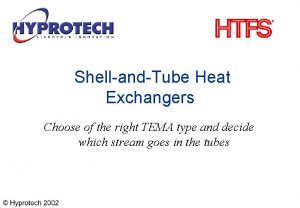Comparison of Heat Exchangers Courtney Mc Loud Jojo

- Slides: 1

Comparison of Heat Exchangers Courtney Mc. Loud, Jojo Steiner, Meghan Moore, Department of Chemical Engineering, University of New Hampshire HFR Introduction 1 Plate Heat Exchanger 3500 CFR 3000 3 Figure 3. Cross method of varying flow rates (CFR=cold flow rate, HFR=hot flow rate) Co-current and Counter-current Similarity 3000 2000 11000 16000 21000 26000 Re(hot steam) Figure 5. Plate Heat Exchanger correlation, R²=0. 880, Adjusted R²=0. 871 1800 Shell and Tube Heat Exchanger Tubular Heat Exchanger 1600 U (W/m²K) Results Re(cold) mid 1000 6000 Statistical Methods A Multilinear Regression was performed on the hot and cold stream data versus the calculated heat transfer coefficient to determine any potential relationship. • Main variables observed were the rate of heat transfer (q), surface area (As), and log mean temperature difference (ΔTlm , LMTD method. ) • Calculation of Re determined relationship between flow rate and U Re=ρVD/μ Equation 2 • The overall heat transfer coefficient was solved using the LMTD Method. q=UAΔTlm Equation 1 2500 1500 • This was performed for co-current and countercurrent flow by changing the direction of the hot water inlet (Figure 1). Figure 1. Co-current (parallel) flow (left) and countercurrent flow (right) [3]. Re(cold) high 1400 U (W/m²K) 1 2 3 U (W/m²K) • Test the effects that a Plate, Tubular, and Shell and Tube Heat Exchangers had on the overall heat transfer coefficient (U) and Reynolds Number (Re). • Determine if Co-current or Countercurrent flow affected U or Re. Design Problem 1200 1000 1400 1200 1000 800 600 1000 600 2000 3000 Re (hot stream) Figure 6. Tubular Heat Exchanger correlation, R²=0. 877, Adjusted R²=0. 868 400 1000 1600 Re(hot stream) Figure 7. Shell and Tube Exchanger correlation, R²=0. 816, Adjusted R²=0. 803 Methods Materials Tubular Heat Exchanger (Armfield) Shell and Tube Heat Exchanger (Armfield) Plate Heat Exchanger (Armfield) Computer (Labworks II) A B U (W/m²K) 2500 2000 1500 1000 5000 10000 15000 20000 25000 Re(hot stream) C Plate counter Tubular counter Shell and Tube counter Plate co Tubular co Shell and Tube co Figure 4. High similarity in correlation between the Reynold’s number of the hot stream and the overall heat transfer coefficient for each exchanger for counter-current and co-current flow type. Error bars represent standard deviation from multiple trials. Figure 2. Tubular Heat Exchanger (A), Shell and Tube Heat Exchanger (B), and Plate Heat Exchanger (C). Procedure • Varied flow rates in a cross technique for each heat exchanger and recorded temperature at both inlets and outlets. Table 1. Correlations for each Heat Exchanger Type Plate Correlation 653. 2+0. 06016(Rec)+0. 0622(Reh) Tubular 274. 0+0. 06816(Rec)+0. 2416(Reh) Shell and Tube 358+0. 6329(Rec)+0. 3851(Reh) • The most common arrangement for flow patterns within a heat exchanger are co-current (parallel) and countercurrent flow (Figure 1). The average U values for the co-current arrangement for the flat plate, tubular, and shell and tube heat exchangers were very similar to those in the countercurrent arrangements. • Therefore the flow direction had little effect on the resulting U. • Due to the difference in surface area of the exchangers, the flat plate exchanger had a higher value of U than both the shell and tube and tubular exchangers for co and counter flow arrangements. • The compact design of the flat plate exchanger allowed for more area of heat transfer. • This factor allows for the flat plate exchanger to have the same thermal capacity as a tubular heat exchanger as much as five times its size [2]. • Increased flow rate from the cold stream while maintaining a constant flow rate from the hot stream also resulted in a higher U value for each exchanger at both flow arrangements. • This was due to the increased temperature difference that was observed for higher cold stream flow rates. Conclusions • The Plate Heat Exchanger had the largest U for both co and countercurrent arrangements. • The shell and tube and tubular exchangers had similar U values for both co and counter current. • Co-current and Countercurrent flow had little to no effect on U. • Higher flow rates resulted in higher U values. • Regression correlations accurately depict experimental data. References [1] C. Geankoplis, Transport processes and unit operations. Engelwood Cliffs, N. J. : PTR Prentice Hall, 1993. [2] Inc, B. H. (2010) The flat plate heat exchanger in comparison with other types of heat exchangers. (Accessed: 25 April 2016). [3] Edge, E. (2000) Parallel and counter flow designs heat exchangers. (Accessed: 25 April 2016).

